Pest and Diseases in the Market Garden - Hallo sahabat
How to Plant Vegetable, Pada Artikel yang anda baca kali ini dengan judul Pest and Diseases in the Market Garden , kami telah mempersiapkan artikel ini dengan baik untuk anda baca dan ambil informasi didalamnya. mudah-mudahan isi postingan yang kami tulis ini dapat anda pahami. baiklah, selamat membaca.
Judul :
Pest and Diseases in the Market Garden link :
Pest and Diseases in the Market Garden
Baca juga
Pest and Diseases in the Market Garden
Our chief strategy to deal with pest and disease in the vegetable gardens is to reduce plant stress levels as much as possible. We achieve this by well timed planting out, providing adequate irrigation and building healthy soils with diverse microbiology to nurture the plants.

Other steps we take are to try many cultivars and stick with the ones that perform best, grow our own plants from seed and only select the healthiest seedlings (for some species we save seed from the best performing plants). We also plant in polycultures to make it more difficult for pests to locate our plants and we introduce various habitats in the gardens for pest predators such as hedgehogs, birds, snakes, lizards, frogs, toads, ladybirds, wasps, mantids and beetles. Finally we practice manual pest removal for certain pests such as Cabbage White eggs and Brassica Bug adults. Our aim with pest and disease organisms is not to entirely eliminate them but to reduce them to a point where they do not make significant damage.
Victoria Bezhitashvili who has joined us for the polyculture study this year has been observing and recording pests and diseases found within the market garden specifically those that interact with the annual vegetable crops. Below you can see a record of her initial observations made in April-May. Another set of observations will be recorded later in the year to follow up. Many thanks Victoria for this report!
Pest and Disease Records - Annual Vegetable Crops in the Polyculture Beds - 2018 by Victoria Bezhitashvili
| CROP | FAMILY | PROBLEM | LEVEL OF DAMAGE
(IMPACT ON PRODUCTIVITY)
April - May |
Kale
Brassica oleracea var. sabellica | Brassicaceae | Whitefly (Aleyrodes proletella) - most plants
Leaf miner – some plants
Caterpillars of Cabbage white butterfly (Pieris rapae) - some plants | Not significant separately, combined effect can be significant |
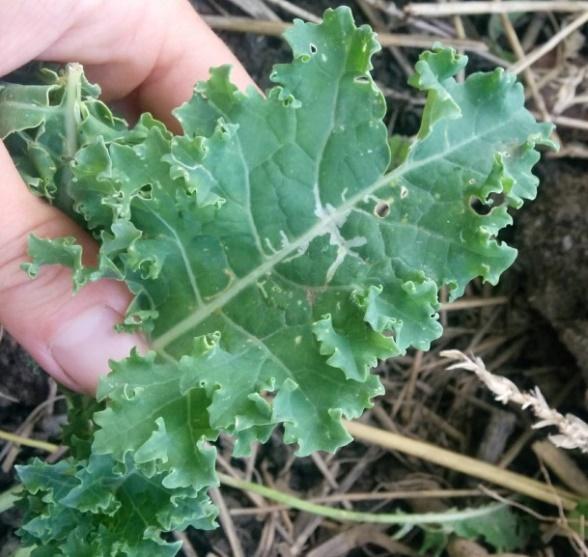 |
| Leaf miner (unidentified) on kale plant |
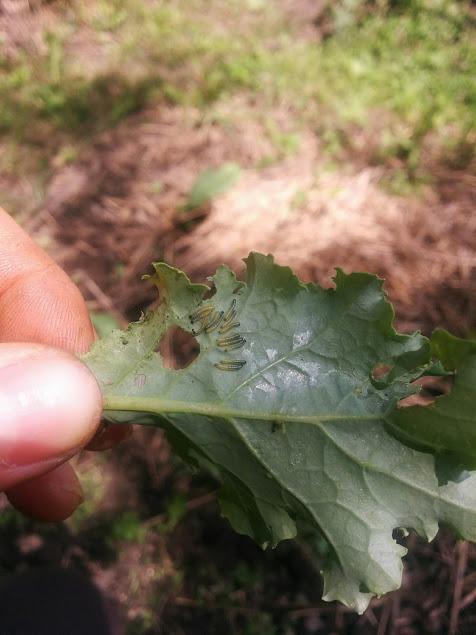 |
| Newly hatched caterpillars of Cabbage white butterfly (Pieris rapae) on kale plant |
| CROP | FAMILY | PROBLEM | LEVEL OF DAMAGE
(IMPACT ON PRODUCTIVITY)
April - May |
Beans
(Phaseolus vulgaris), bush beans and climbing beans | Fabaceae | Bacterial bean blight (prob. Halo blight, caused by Pseudomonas syringae pv. phaseolicola)– some plants
Eaten leaves (prob. True bugs)
prob. Black bean aphid Aphis fabae, farmed by ants | Not significant
Not significant
Not significant |
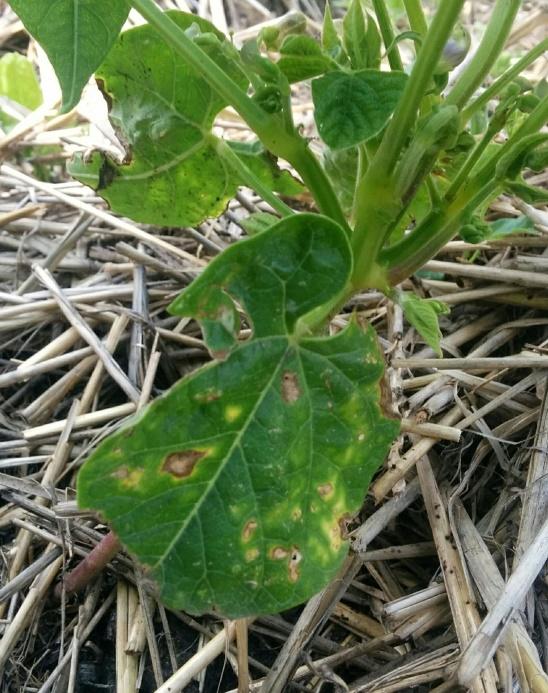 |
| Bacterial bean blight (prob. Halo blight, caused by Pseudomonas syringae pv. phaseolicola) |
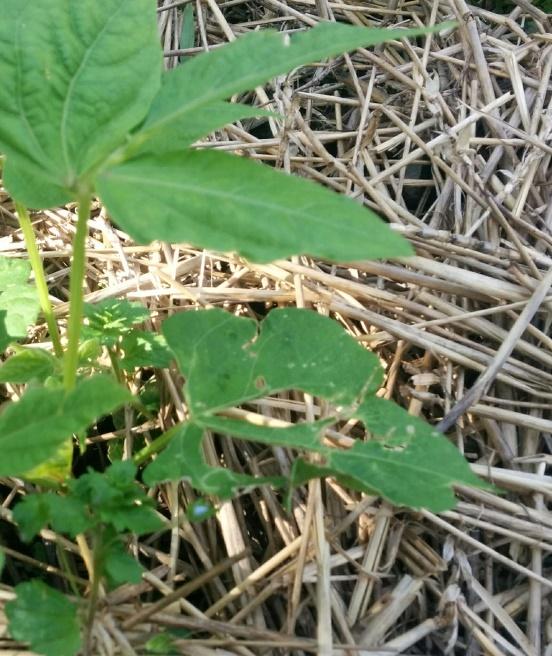 |
| Bean leaves, eaten by prob. true bugs |
| CROP | FAMILY | PROBLEM | LEVEL OF DAMAGE
(IMPACT ON PRODUCTIVITY)
April - May |
| Maize (Zea mays), 2 different varieties | Gramineae | One variety - stunted growth in the shaded area, chlorosis (pale colour)
The third variety – new leaves curled, distorted, pale, prob. virus – third of plants | Potentially Significant
Potentially Significant |
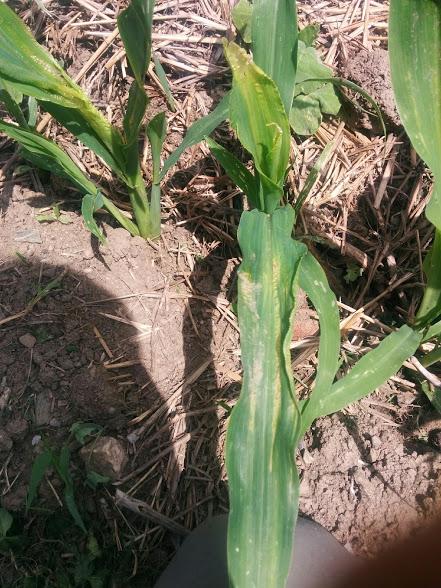 |
| Distorted new corn leaves, prob. virus |
| CROP | FAMILY | PROBLEM | LEVEL OF DAMAGE
(IMPACT ON PRODUCTIVITY)
April - May |
| Early Potatoes | Solanaceae | Eaten leaves (prob. True bugs)
Wilted leaves, spots, necrosis of old leaves (Late blight, caused by the fungus-like oomycete pathogen Phytophthora infestans) | Not significant
Not significant at the moment of check, potentially can have a negative impact |
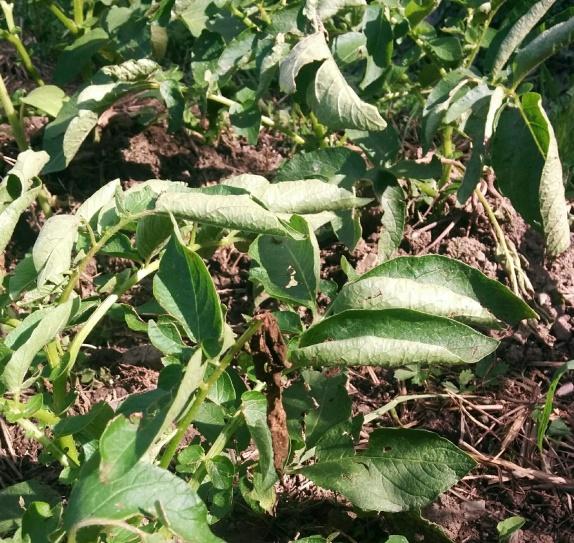 |
Wilted potatoes leaves, spots, necrosis (Late
blight - Phytophthora infestans) |
| CROP | FAMILY | PROBLEM | LEVEL OF DAMAGE
(IMPACT ON PRODUCTIVITY)
April - May |
Sunflower
Helianthus annuus | Asteraceae | Eaten leaves (prob. True bugs)
Those near Paulownia – chlorosis (prob. N deficiency or lack of water), spots (secondary fungal infection), necrosis | Not significant
Can be significant |
 |
| Sunflower leaf |
| CROP | FAMILY | PROBLEM | LEVEL OF DAMAGE
(IMPACT ON PRODUCTIVITY)
April - May |
Parsnip
Pastinaca sativa | Apiaceae | Maggot of celery leaf mining fly Euleia heraclei
– one plant
Eaten leaves (prob. True bugs) | Not significant
Not significant |
 |
Maggot of celery leaf mining fly Euleia heraclei
on a parsnip plant |
| CROP | FAMILY | PROBLEM | LEVEL OF DAMAGE
(IMPACT ON PRODUCTIVITY)
April - May |
Beetroot
Beta vulgaris | Chenopodioideae | Eaten leaves (not specific pest)
Cercospora leaf spot, caused by the fungus Cercospora beticola | Not significant
Not significant, potentially can have an impact on beet size |
 |
Cercospora leaf spot on beetroot, caused by the fungus Cercospora beticola |
| CROP | FAMILY | PROBLEM | LEVEL OF DAMAGE
(IMPACT ON PRODUCTIVITY)
April - May |
Broccoli
Brassica oleracea var. italica | Brassicaceae | Whitefly (Aleyrodes proletella) – all plants
Aphids (green (Cabbage aphid -Brevicoryne brassicae) and black)
The harlequin cabbage bug (Murgantia histrionica)
Cabbage Curculio - a small weevil (Ceutorhynchus rapae)
Caterpillars of Cabbage white butterfly (Pieris rapae) - some plants | Potentially Significant on some plants
Combined effect can be significant
Older plants are more resilient |
 |
| Brassica or Cabbage Bug (Eurydema oleracea) |
 |
| Whitefly (Aleyrodes proletella) on broccoli plant |
 |
| Necrosis by prob. heat wave on young broccoli plant |
 |
Cabbage Curculio - a small weevil
(Ceutorhynchus rapae) on broccoli plant | |
|
 |
| Aphids on broccoli plant eaten by Ladybug |
 |
| Caterpillar of Cabbage white butterfly (Pieris rapae) on broccoli plant |
| CROP | FAMILY | PROBLEM | LEVEL OF DAMAGE
(IMPACT ON PRODUCTIVITY)
April - May |
Squash
Cucurbita pepo | Cucurbitaceae | Powdery mildew Erysiphe cichoracearum – mild on old plants, prominent on young
Leaf miner – one plant
Uniform chlorosis on some plants – prob. N deficiency | Not significant
Not significant
Not significant |
 |
| Powdery mildew Erysiphe cichoracearum on young squash plant |
 |
| Uniform chlorosis on old leaves (N deficiency??), squash plant |
| CROP | FAMILY | PROBLEM | LEVEL OF DAMAGE
(IMPACT ON PRODUCTIVITY)
April - May |
Basil
Ocimum basilicum | Lamiaceae | Chlorosis, wilting, stunted growth, spots– replanting, deficiency, bacteria (???)
Prob. Downy mildew Peronospora belbahrii/ too weak plants during replanting | Potentially Significant |
 |
| Weak and damaged basil plants, multiple influencing factors |
| CROP | FAMILY | PROBLEM | LEVEL OF DAMAGE
(IMPACT ON PRODUCTIVITY)
April - May |
Turnip
Brassica rapa subsp. Rapa
Swede
Brassica napobrassica) | Brassicaceae | Brassica or Cabbage Bug (Eurydema oleracea)
Chlorosis and necrosis of old leaves – investment into roots
Dark leaf spot - prob. Alternaria brassicicola | Not significant
Not significant
Not significant |
 |
Brassica or Cabbage Bug (Eurydema oleracea)
on turnip plant (grown next to broccoli) |
 |
| Senescence of old leaves on turnips |
| CROP | FAMILY | PROBLEM | LEVEL OF DAMAGE
(IMPACT ON PRODUCTIVITY)
April - May |
Tomato
Solanum lycopersicum | Solanaceae. | Chlorosis and necrosis of old leaves, spots – late blight, caused by the fungus-like oomycete pathogen Phytophthora infestans | Potentially can be significant, previous experience proved no impact on fruits |
 |
Late blight on tomatoes, caused by the fungus-like
oomycete pathogen Phytophthora infestans |
| CROP | FAMILY | PROBLEM | LEVEL OF DAMAGE
(IMPACT ON PRODUCTIVITY)
April - May |
Cucumber
Cucumis sativus | Cucurbitaceae | Necrosis of leaves edges, spots holes – prob. downy mildew (caused by the oomycete Pseudoperonospora cubensis)
Green caterpillar (only nest?) | Not significant |
 |
prob. downy mildew (caused by the
oomycete Pseudoperonospora cubensis) on cucumber plant |
 |
prob. downy mildew (caused by the oomycete
Pseudoperonospora cubensis) on cucumber plant |
If you would like to create a forest garden and gain some practical hands on experience join us this Spring. We'll be covering site surveying, landscape design software, installing access, beds, irrigation channels, planting tree, shrub, herb and ground layers and making a small wildlife pond. All in 3 days! And plenty of follow up material to take away with you to digest slowly.
 |
If you appreciate the work we are doing you can show your support in several ways.
|
Demikianlah Artikel Pest and Diseases in the Market Garden
Sekianlah artikel Pest and Diseases in the Market Garden kali ini, mudah-mudahan bisa memberi manfaat untuk anda semua. baiklah, sampai jumpa di postingan artikel lainnya.
Anda sekarang membaca artikel Pest and Diseases in the Market Garden dengan alamat link https://howtoplanvegetable.blogspot.com/2018/07/pest-and-diseases-in-market-garden.html





Belum ada Komentar untuk "Pest and Diseases in the Market Garden "
Posting Komentar